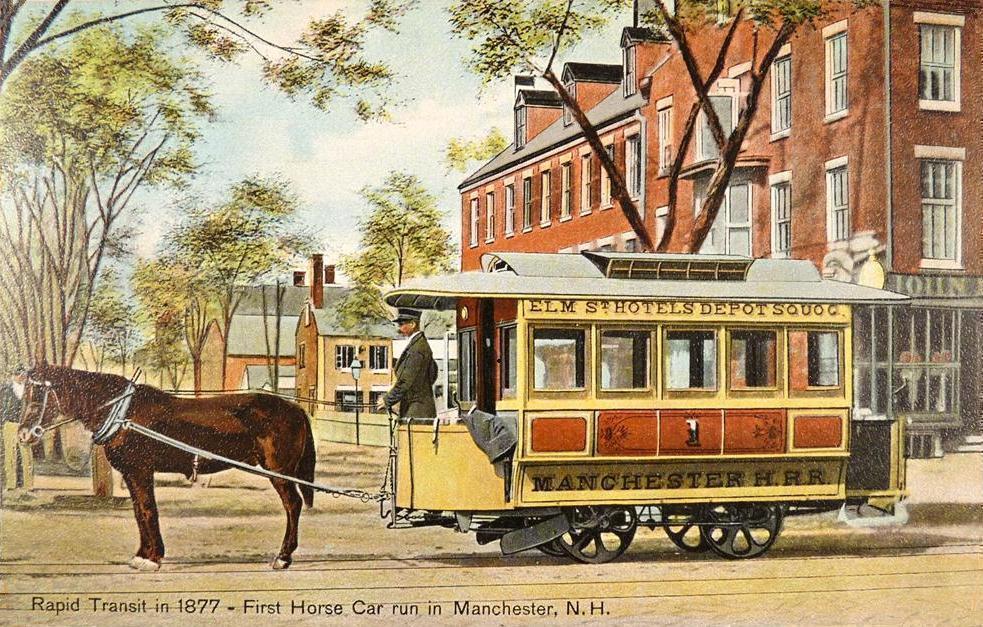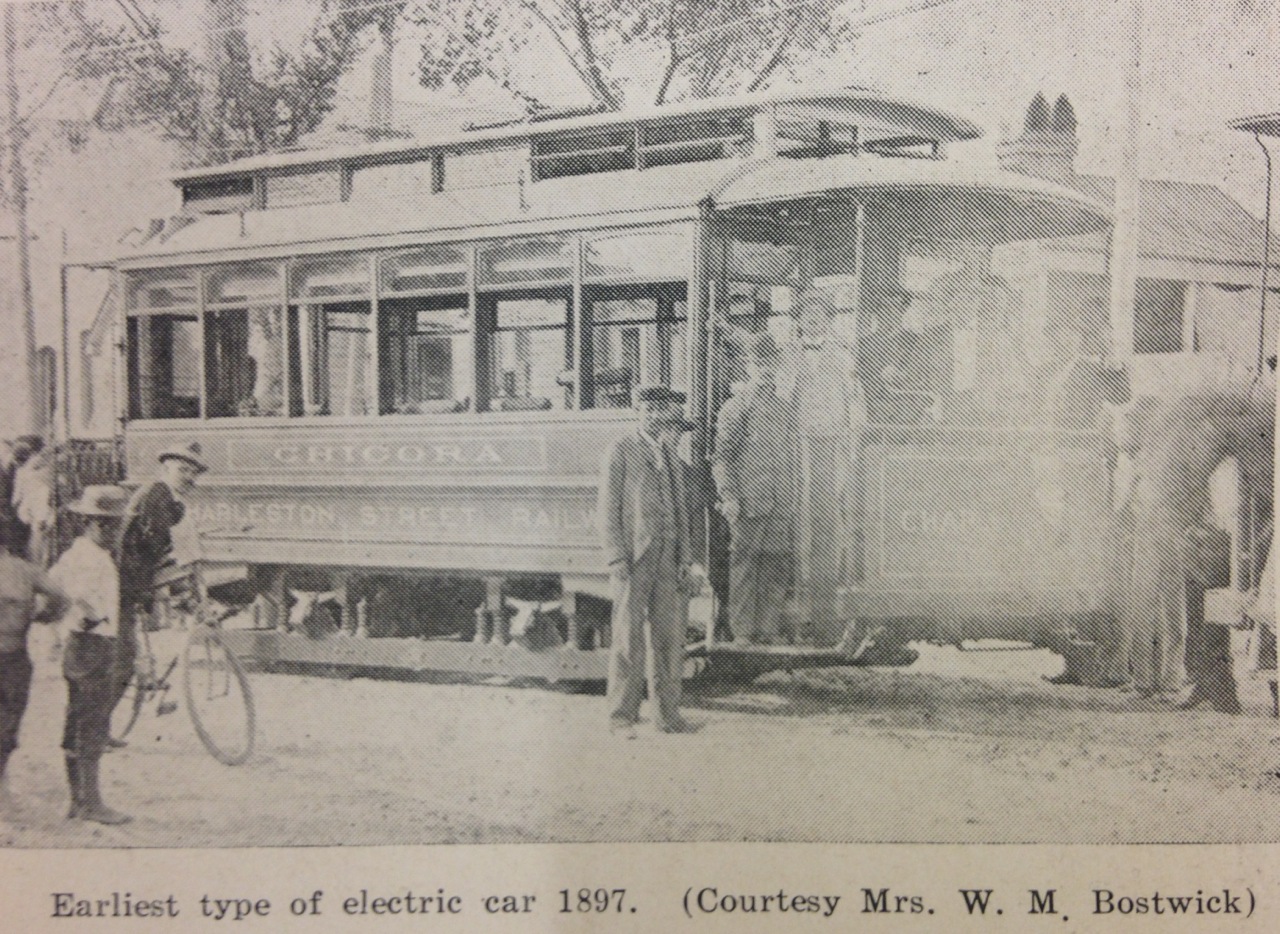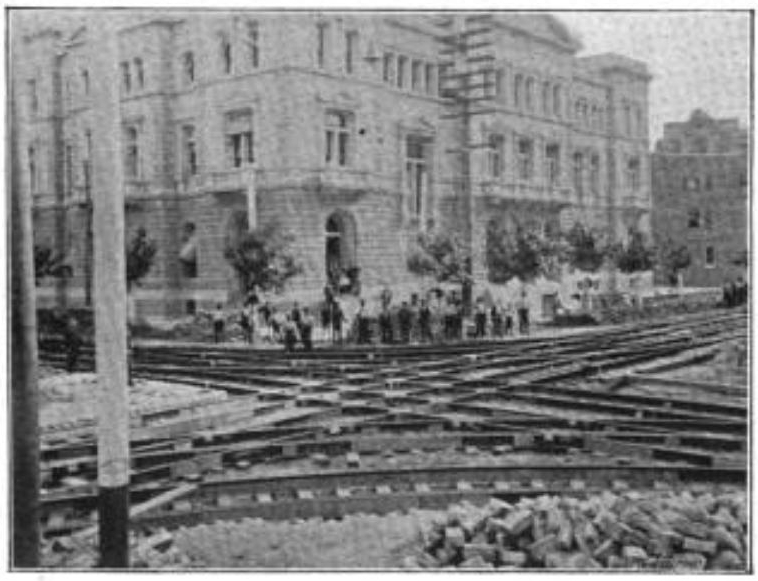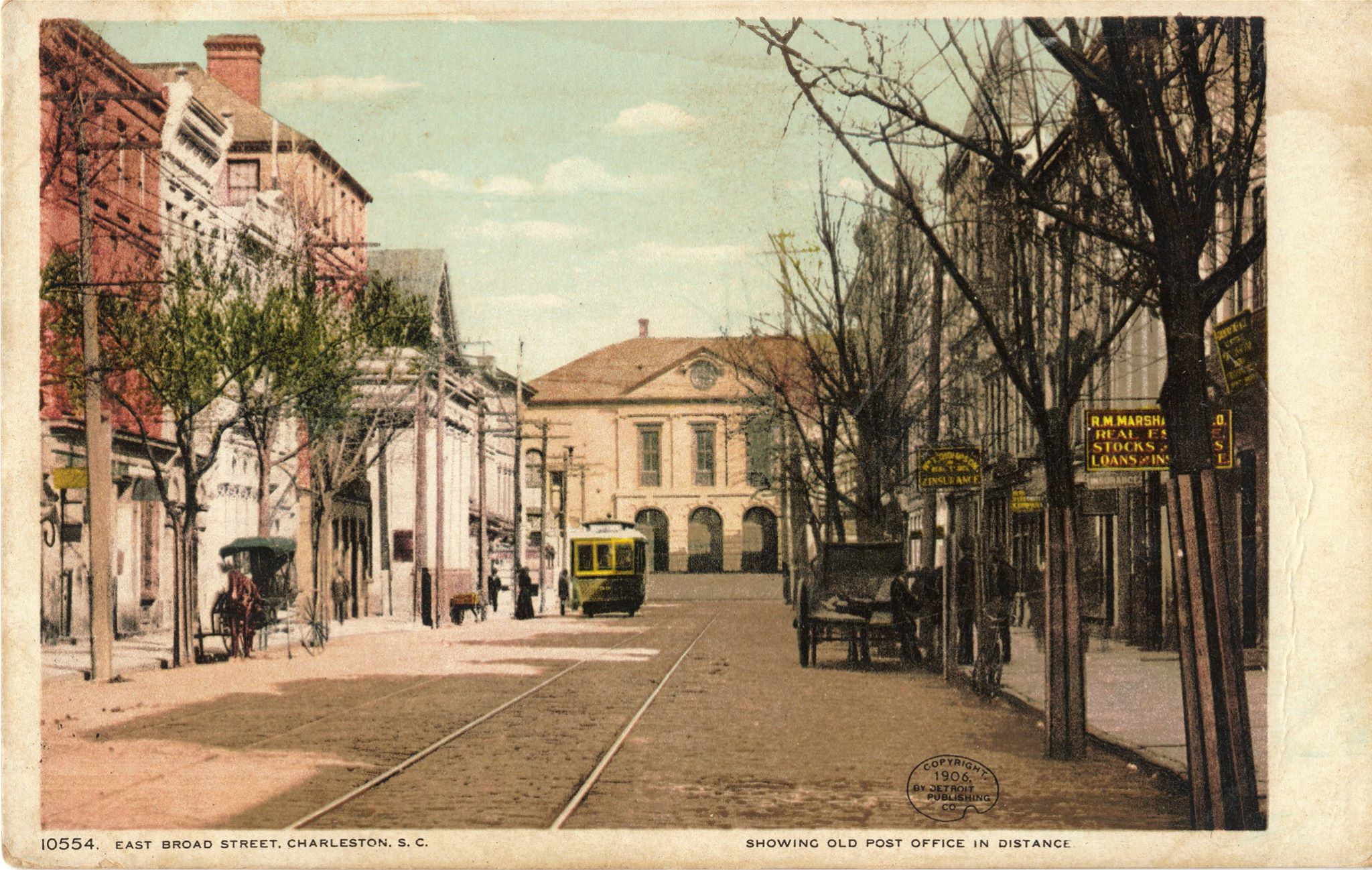
Horse-drawn streetcars and electric trolleys might today seem like quaint vestiges of the obsolete past, but the debut of Charleston’s first street railway in 1866 marked the beginning of a golden age of local mass transit. Since traffic is currently a major issue in the Lowcountry, and May is National Mobility Month, let’s take a spin through history on a streetcar named “Progress.”
In 2014, the City of Charleston hired Gabe Klein, a transportation consultant with an international reputation, to assess the state of traffic in and around the city and to submit his recommendations for improvement. Mr. Klein’s number-one suggestion, among a list of ten-year goals in his published report, was short and simple: “Bring back the trolleys.” Why? “Bringing a trolley/streetcar system back to the peninsula could provide the basic [transportation] back-bone that is sorely needed,” he said, “and would also celebrate the historical aspects of the city.”[1]
After hearing Mr. Klein’s suggestion, which advocates the use of modern technology rather than vintage vehicles, several community leaders invited me to construct a program about Charleston’s streetcar history. Now, I wouldn’t describe myself as a “railroad enthusiast” or a twentieth-century historian, but I quickly got on board with this challenge. If we’re going to try to solve our present and future traffic issues by revisiting an earlier mode of transportation, we need to begin with a study of the motivations and logistics behind the rise and fall of that forgotten system. So I did some research and compiled a PowerPoint to summarize the highlights and low points of Charleston’s former streetcars system. I’ve had the pleasure of presenting that material to a number of audiences over the past several years, and now I’ll try to condense it into a two-part podcast.
Let’s start with a bit of fundamental background. A railroad is a fixed path or track made of two parallel metal rails. A wheeled vehicle rolling along such rails, regardless of how it is powered, moves with greater efficiency and less resistance than a comparable vehicle moving along the bare surface of the earth. Since very few streets or roads were paved with smooth, solid materials before the twentieth century, the advent of commercial rail roads in the second quarter of the nineteenth century represented a significant improvement in the long-distance conveyance of materials and people.

The South Carolina Canal and Railroad Company, like similar ventures of that era, was largely a rural phenomenon. The early years of the railroad boom were dominated by agricultural and industrial concerns—moving goods and materials from one place to another—and the iron roads spanned the distances between far-flung towns, cities, and port facilities. The transportation of passengers was initially a lesser concern. The movement of goods and/or passengers within the urban confines of a city was an even lower concern. As railroad technology and its infrastructure matured, however, investors began exploring the idea of using railroads to move people around the expanding urban landscape.
The rise of urban railroads, or street railways using “streetcars,” around the middle of the nineteenth century was, in many ways, the logical evolution of an earlier form of urban mass-transit, the omnibus. In case you’re not familiar with this phenomenon, imagine a horse-drawn carriage that’s been stretched lengthwise, with inward-facing bench seats. Back in 2017 I did a podcast (episode No. 29) about the “omnibus revolution(s)” of nineteenth- and twentieth-century Charleston. The Palmetto City had a network of commercial omnibuses starting in 1833, around the same time as most other European and American cities. In that same year, coachbuilder John Stephenson patented a horse-drawn rail car for passenger use in New York City. This hybrid of the omnibus and railroad combined an existing power source with a smoother and more efficient ride, and it slowly gained popularity among both customers and investors. By the 1850s, many cities were clamoring for horse cars, as they were sometimes called, to meet the demand of their growing urban populations. Boston’s street railway debuted in 1856, followed soon after by similar services in Philadelphia, Cincinnati, Baltimore, and Chicago.

Two weeks later, the committee, headed by Mayor Charles Macbeth, reported their support for the proposal with “the warmest approbation.” The plan was, “in their judgment, in the right direction, [and] should be met in the most liberal spirit, and no obstacles be interposed to its successful prosecution. The experience of other cities has more than realized all that the most sanguine anticipated from street passenger rail roads, and the prospect of such an improvement here should be hailed with pleasure.” Because the streets of Charleston were public highways, however, the investors needed to obtain a corporate charter from the state government. The purpose of this initial communication, therefore, was merely to see whether or not City Council was inclined to support the plan before the investors committed the necessary resources to bring it to fruition. In response, the members of Charleston’s City Council resolved that they would “afford every facility in their power to the prosecution of so public-spirited an enterprise.”[3]
The Charleston City Railway Company received its corporate charter from the South Carolina General Assembly in late January 1861. Several weeks later, on April 9th, the new company asked Charleston’s City Council for permission to commence laying iron rails in the city streets. Council appointed a committee to consider their request, but that committee (and everyone else in town) was soon distracted by the first shots of the Civil War on April 12th. When the committee did finally submit its report in early May, 1861, the city leaders adopted a resolution stating that it was “inexpedient at this time, in view of the troublous aspect of public affairs, for City Council to undertake any new improvements.”[4]

Another editorial, published in early September 1865, suggested that an urban street railway system in post-war Charleston was likely to be far more profitable in than it might have been several years earlier. “The importance of such an enterprise is as great now as it was then. The considerations of convenience and economy in travel and transportation, of inconvenience resulting from drays and other wheel[ed] vehicles in our crowded streets, the noise, dust, and damage to the streets and ways, all operate now as they did before, and as a measure of public interest, therefore, there can be little question, we presume, as to its utility.” The chief post-war difference, however, was the city’s demographic character. Prior to the war, one half of the people in the Charleston area were prohibited from moving about the city without the permission of their legal owners. The abolition of slavery had emancipated that large urban labor force, of course, and now those people, as well as others streaming into town from the countryside, were searching for new residences and new employment. As the city’s population grew and spread northward in the coming years, taking advantage of cheaper lodgings on the suburban outskirts of town, the new street railway could potentially make a handsome profit by facilitating the mobility of the laboring masses. The streetcar enterprise “will not be wanted immediately,” opined the editor of the Charleston Daily News, “but it will be wanted before it can be completed.”[6]
On October 17th, 1865, the directors of the Charleston City Railway Company appeared before the recently-revived City Council to ask permission to lay track in the city streets. Their initial proposal included a route that would run “from a point in Broad-street near the building known as the Exchange, from thence to run up Broad-street to Meeting-street, from thence to run up Meeting-street to Calhoun Street, from thence to run through Calhoun-street to King-street, from thence to run up King-street to the corner of King and Shepherd-streets, with a branch line to intersect with the main line at a point in Meeting-street opposite Hasell-street, from thence to run through Hasell-street to King-street, from thence to run up King-street to Wentworth-street, from thence to run through Wentworth-street to Rutledge Avenue, from thence to run up Rutledge Avenue to the corner of Rutledge Avenue and Shepherd-street.”

The Charleston City Railway Company began publishing requests for proposals in December of 1865, and the work of excavating the sandy, unpaved streets and installing the iron rails began in the spring of 1866. A variety of inevitable complications and delays ensued during the course of the year, principally due to the difficulty of procuring the necessary materials from up North, but the general contractor, Daniel Owen, pushed his workmen to complete the works before the deadline. By December, the “main line” of track was in place and laborers were nearly finished installing brick paving between the rails. The first of the city’s streetcars arrived by steamboat from the New York workshop of John Stephenson on December 2nd. Identified as car No. 31, the first arrival featured “richly gilt letters on the upper panels of either side” to identify its intended circular route: “Broad, Meeting, Calhoun, and King-streets.”[8]
On December 4th, the Charleston Courier proclaimed the City Railway to be an “accomplished fact.” The streetcar company had suffered through “frequent vexatious, yet unavoidable delays,” but its managers had persevered and brought its plan to fruition. The core route of the proposed service was now complete, and the company published its “rates of fare”: a single ride cost ten cents, but volume discounts were available on a sliding scale if one purchased three or more tickets; students and children under twelve were eligible to purchase twenty-five tickets for $1.00. After a few more days of paving, and after the arrival of a few more the cars from New York, the rail system would finally commence running. From that moment, said the Courier, the Charleston “street railway will hereafter be one of the fixed and indispensable institutions of our beloved city.”[9]

The opening of the city’s first street railway in mid-December 1866 marked the beginning of a vibrant, popular, profitable, and efficient mode of transportation for the residents and visitors of urban Charleston that lasted for just over seventy-one years. It commenced with a few cars riding on a four-mile downtown loop, but quickly expanded in subsequent months and years. A branch line through Wentworth Street and Rutledge Avenue opened on December 27th, and a spur leading down Meeting Street, south of Broad, to White Point Garden, opened on March 20th, 1867. An extension of the Meeting Street line to Magnolia Cemetery opened later in the year. Meanwhile, additional cars continued to arrive from New York and were immediately put into service. In late March, the railway company announced that they would soon add one additional car to each route expressly for the accommodation of “colored people.”[11] Considering the Reconstruction spirit of the times, however, this proposed addition was too little, too late.
On March 26th, 1867, about two thousand African-American citizens gathered on Citadel Green (now called Marion Square) for a political rally to celebrate their new civil rights. As the participants disbursed into the adjacent streets after the meeting, a few unidentified black men felt sufficiently empowered “to test their right to ride upon the street cars in violation of the rules of the Company.” They boarded a car in Meeting Street, were then “politely” invited to leave, but refused. The police were called, then the U.S. Army, and violence ensued. This scene of apparently-spontaneous civil disobedience, which the local press called an “attack on the street cars,” was repeated several times in the ensuing weeks. One of the protesters, a black woman named Mary Bowers, filed a complaint with the local commissioner of the U.S. Freedmen’s Bureau, who in turn appealed to the president of the streetcar company. At a meeting of its board of directors on May 3rd, 1867, the Charleston City Railway Company bowed to a combination of market forces and Federal pressure. Henceforth, they declared, all of Charleston’s street cars would be open to all persons, regardless of color. This civil rights victory was one of many small steps forward during the era of Federal Reconstruction that, unfortunately, were erased by the rise of “Jim Crow” segregation in later decades.[12]

The commercial expansion of street railways was part of a larger intermodal transportation boom in the last quarter of the nineteenth century. Today you’ll hear agents from the State Ports Authority talking about the advantages of intermodal connections—moving from one mode of transportation to another—but the concept has been around for a long time. Consider, for example, that by the summer of 1875 one could take the railroad from New York or the commuter train from Summerville to the rail depot around Ann Street in downtown Charleston, then ride the streetcar to the east end of Market Street, then ride the ferry to Sullivan’s Island, then ride the mule-powered streetcars of the Middle Street Sullivan’s Island Railway to the beachfront, and then reverse the steps—all without personally owning or driving a vehicle. This was the golden age of public transportation in the United States.
In the sixty-odd years between the appearance of John Stephenson’s first street rail cars in the early 1830s and the close of the nineteenth century, the only major change in this industry was the move towards electrification. In the late 1880s, inventor Frank Sprague, a former Edison employee, created the apparatus to power a streetcar with electricity by using a spring-loaded pole, called a “trolley,” to interface with a network of electric wires suspended above the path of the railway. This “trolley” system gave a name to a new generation of urban streetcars powered by an invisible force rather than traditional horse power. Throughout the 1890s, cities and towns across America traded in their tired horse cars for new-fangled trolleys.

Commencing work in late November 1896, the Charleston Street Railway Company erected a series of tall wooden posts along the city streets to support a network of overhead electrical lines to power the new trolley cars. A coal-powered electrical generation station was built on the east side of upper Meeting Street (the present site of the Meeting Street Academy). Across the street, the company erected a large “car barn” for storing and repairing the trolleys (now the American College of the Building Arts at 649 Meeting Street). The company also disrupted traffic in many of the principal streets for several months by digging out some of the old tracks and installing new rails (and new paving).
On Carolina Day, June 28th, 1897, the new electric “trolleys” made their Charleston debut with seventeen “closed cars,” eight “open cars,” and one “special” car that could be hired for festive occasions (additional cars were added in subsequent months and years). While the city’s original streetcars were fitted with inward-facing bench seats, all of new vehicles were of the the “center aisle, cross seat type.” This new seating arrangement proved to be very popular in Charleston, noted the national Street Railway Journal, “partly because of the pleasure of riding forward, and partly because this type of car lends itself better to the peculiar race conditions found in Charleston than the [older] side seat cars.”
On opening day, the new Charleston Street Railway Company offered customers an impressive 24.5 miles of circular and linear routes, including a suburban expansion to the north of the city limits. The tracks now extended up “the Neck” about five miles along Meeting Street Road, “past many negro settlements and through large truck farms to the phosphate mills” along the Ashley River. A short time later, the Street Railway Company extended its track to the city’s new Chicora Park, which became part of the U.S. Navy Yard in 1901.[14]

From that point at the close of the nineteenth century, the people of the Charleston metropolitan area enjoyed an unprecedented degree of regional mobility. This privately-owned, intermodal network of public mass transit provided convenient and economical access to a wide variety of residential, commercial, and recreational opportunities. It was both profitable and popular, and its expansion could have easily continued further to the east of the Cooper River, west of the Ashley, and north of Charleston Neck. In 1900, however, just one year after the creation of the Consolidated Railway company, the first locomobile arrived in Charleston, and everything changed. Tune in next week, when we’ll track the slow decline of Charleston’s trolley service and consider its enduring legacy on the streets of community today.
[1] Gabe Klein, “Charleston, South Carolina, Peninsula Mobility Report,” November 2014, pages 6–9.
[2] Charleston Courier, 10 November 1859, proceedings of City Council meeting of 8 November 1859.
[3] Charleston Courier, 24 November 1859, proceedings of City Council meeting of 22 November 1859.
[4] See Charleston Courier, issues of 11 April, 25 April, and 9 May 1861, containing the proceedings of City Council meetings of 9 April, 23 April, and 7 May 1861.
[5] Charleston Courier, 1 April 1865, “A City Rail Road.”
[6] Charleston Daily News, 2 September 1865, “Street Railways.”
[7] Charleston Courier, issues of 20 October and 24 November 1865, containing the proceedings of City Council meetings of 17 October and 21 November 1865.
[8] Charleston Courier, 3 December 1866, “The Street Railway.”
[9] Charleston Courier, 4 December 1866, “The Charleston City Railway an Accomplished Fact,” and “Rates of Fare.”
[10] Charleston Courier, 17 December 1866, “Inauguration of the Charleston City Railway”; “The City Railway”; and advertisement for “Charleston City Railway Company.”
[11] See Charleston Courier, issues of 27 December 1866; 13 March, and 18 March 1867.
[12] See William C. Hine, “The 1867 Charleston Streetcar Sit-ins: A Case of Successful Black Protest,” South Carolina Historical Magazine 77 (April 1976): 110–14.
[13] For more information about the Enterprise company, see Thomas T. Fetters, Palmetto Traction: Electric Railways of South Carolina (s.l.: by the author, 1978), 11.
[14] Street Railway Journal, Vol. 13, No. 9 (September 1897): 517–23, “Electric Railways in Charleston.”
PREVIOUS: The Charleston Riot of 1919
NEXT: The Decline of Charleston’s Streetcars
See more from Charleston Time Machine
